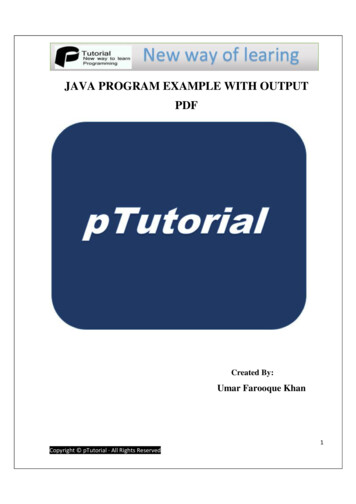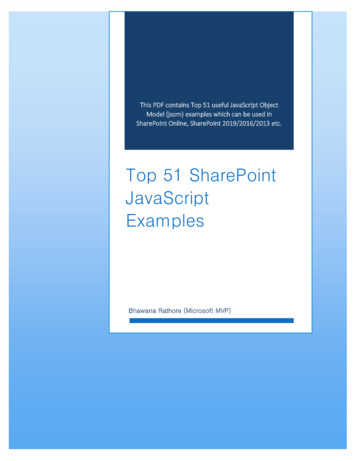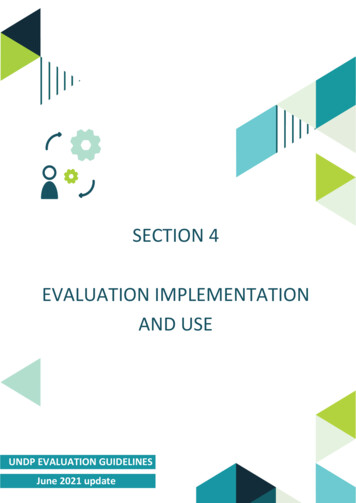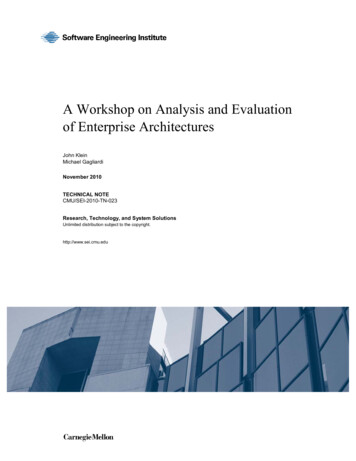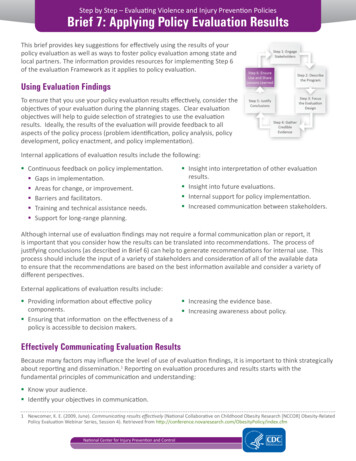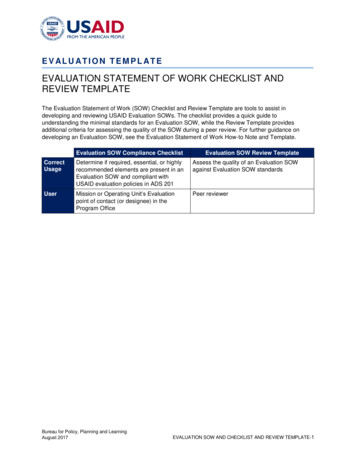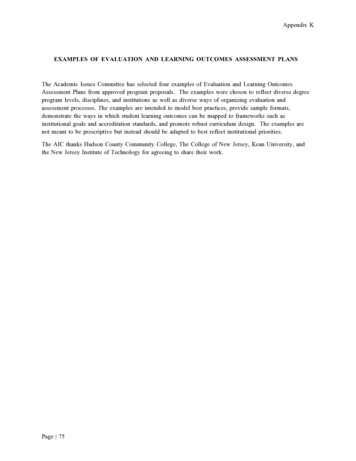
Transcription
Appendix KEXAMPLES OF EVALUATION AND LEARNING OUTCOMES ASSESSMENT PLANSThe Academic Issues Committee has selected four examples of Evaluation and Learning OutcomesAssessment Plans from approved program proposals. The examples were chosen to reflect diverse degreeprogram levels, disciplines, and institutions as well as diverse ways of organizing evaluation andassessment processes. The examples are intended to model best practices, provide sample formats,demonstrate the ways in which student learning outcomes can be mapped to frameworks such asinstitutional goals and accreditation standards, and promote robust curriculum design. The examples arenot meant to be prescriptive but instead should be adapted to best reflect institutional priorities.The AIC thanks Hudson County Community College, The College of New Jersey, Kean University, andthe New Jersey Institute of Technology for agreeing to share their work.Page 75
Appendix KII. Evaluation and Learning Outcomes Assessment PlanProgram Assessment PlanHCCC Institutional Goals To provide liberal arts and sciencecourses and associate degreeprograms that will preparestudents to transfer to four-yearcolleges and universitiesProgram Learning OutcomesUpon successful completion of theprogram graduates will be able totransfer seamlessly to a seniorinstitution or participate in the workforce at entry-level.How Learning Outcomesare AssessedRetention/Graduate/Transfer ratesAnalysis (Cohort Study)Surveys of Recent Graduates, 3Year Graduate Follow Up surveysSurvey of Employers (1 year aftergraduate cohort) To provide courses, certificates andassociate degree programs thatwill prepare students for immediateemployment or provide forcareer enhancement.Graduates of AS Criminal Justicewill be able to:Explain the interdependentoperations of the majorcomponents of the criminal justicesystem (Police, Courts,Corrections)Describe the history, nature andpurpose of the Juvenile Courts,Processing, and Adjudication ofJuvenile Offenders in the JuvenileJustice System.Demonstrate knowledge of themajor criminological theories.Analyze the major historical andcontemporary issues affectingsociety with respect to diversity. To provide general educationcourse to ensure that students canthink critically and analytically,communicate effectively, solvemathematical problems, participateas informed citizens, appreciatecultural diversity and globalinterdependence, and areinformation and computer literate.Page 76Evaluate the nature, extent,causation, and prevention of crime.Demonstrate knowledge andcompetencies that reflect entrylevel professional readiness.Analyze the major historical andcontemporary issues affectingsociety with respect to diversity.Analysis of Transfer StudentPerformance with Native Peers atSenior InstitutionsAssessment of student learningoutcomes at courses and programlevelPerformance/Proficiency Assessment of student learningoutcomes at courses and programlevel through comprehensiveexams and written researchassignments.Performance Analysis –Performance Surveys collectedfrom employers/supervisors atService Learning Site Placement.Performance Analysis will bepresented to Criminal JusticeAdvisory Board annually forfeedback to improve ProgrammaticPlanningPart of on-going assessment ofGeneral Education courses replicate the GE courseassessment with cohort of ASCriminal JusticeSurveys of Employers/ServiceLearning Site PlacementSupervisors will be reviewed by theCriminal Justice Advisory Board foron-going curriculum revision in GEcourses.
Appendix KAssessment of Student Learning Outcomes at Course/Program LevelUpon successful completion of this program graduates will be able to:1. Explain the inter-dependent operations of the major components of the criminal justice system(Police, Courts and Corrections)2. Describe the history, nature and purpose of the Juvenile Courts, Processing, and Adjudicationof Juvenile Offenders in the Juvenile Justice System.3. Demonstrate knowledge of the major criminological theories.4. Analyze the major historical and contemporary issues affecting society with respect to diversity5. Evaluate the nature, extent, causation, and prevention of crime.These program student learning outcomes will be met through coursework and experiential learning.Formative and summative assessment will be conducted throughout the course of studies to ensurestudents meet standards and competencies specified for the courses and program. Common/Department written exams (essay or case studies) and/or research projects inselected major courses are used to ensure the standard mastery of knowledge andanalytical skills across sections of the program.These Common/Departmental assignments are graded using uniform rubrics andaccount for 25-30% of course grade.Students are encouraged to create an electronic portfolio to collect their written reports,position analysis papers and research projects. Selected completed portfolios will bepresented to the Criminal Justice Advisory Board for review and feedback on annualbasis.The table below illustrates how program learning outcomes will be assessed.Page 77
Appendix KProgram Learning Outcomes1. Explain the interdependentoperations of the majorcomponents of the CriminalJustice system.Student Learning Outcomes1.1 : Delineate between the threemajor components of thecriminal justices system Police,Courts, and Corrections.1.2 : Define the concept of CriminalJustice2. Describe the history, natureand purpose of the JuvenileCourts, Processing, andAdjudication of JuvenileOffenders in the JuvenileJustice System.How Program Learning Outcomes are AssessedCourseCRJ 111Intro to CriminalJusticeCRJ 120Intro to CriminalLawMethodWeekly written assignments based on class discussions,reading sources and analyses of case studies.SOC 101Principles ofSociologyFinal Written projects: Describe the student’s understanding of the topic and legalissues, Include a complete analysis of the issue, the history of theissue in the administration of justice, Critically analyze the significance and importance of theissues in the criminal justice system.CRJ 111Intro to CriminalJusticeClass presentation/Role-Play of selected contemporary casestudies.CRJ 120Intro to CriminalLawFinal written Project on issues of criminal law, which will involveresearching the issue using journals, texts and the internet, andanalyzing the importance and relevance of the issue.Student Learning Outcomes:2.1 : Demonstrate an understandingthe various components ofthe juvenile intake system.CRJ 215The JuvenileJustice System2.2 : Describe the nature and extentof delinquencyCRJ 220 GeneralPoliceOrganization &Administration3.Demonstrate knowledge of themajor criminological theories.Student Learning Outcomes3.1: Identify and explain variouslaw enforcement reforms andinnovations and their effectson policing.3.2: Examine and Analyze thehistory of policing in Americaand the relationship that lawenforcement has had with thepublic.4. Analyze the major historical andcontemporary issues affectingsociety with respect to diversity.Student Learning Outcomes4.1 : Demonstrate an understandingof police ethics and situationsleading to deviance.4.2 : Evaluate the critical nature ofexpanding diversity in lawenforcement and criminaljustice administration as awhole.Page 78CRJ 214CorrectionsCRJ 220 GeneralPoliceOrganization &AdministrationResearch paper on a topic in the juvenile justice system. Studentswill be required to 1) describe the student’s understanding of thetopic, 2) include a complete analysis of the issue and the historyof the issue in the administration of juvenile justice and 3) criticallyanalyze the significance and importance of the issue in thejuvenile justice system. Students will present their papers to theclass.Weekly journals (3-4 pages) summarizing the subject matter ofeach class in order to demonstrate their understanding of thetopics covered.Essays of 3 to 5 pages describing, analyzing and evaluatingthree (3) different programs of community policing employed inthe United States.Self-Assessment weekly reports – Service Learning siteCRJ 290 ServiceLearning inCriminal JusticeAnalyses of selected court casesCRJ 220 GeneralPoliceOrganization andAdministrationCRJ 230 Ethics &JusticeCRJ 290 ServiceLearning inCriminal JusticeEssays of 3 to 5 pages pertaining to contemporary issuesconfronting police administrators.Final term paper of 10 to 15 pages applying and evaluating anexisting or proposed policy in criminal justice in the context oftraditional ethical theories or approaches.Self-Assessment weekly reports – Service Learning.Competency Checklist assessed by Employer/Service LearningSite Supervisor
Appendix KProgram Learning OutcomesHow Program Learning Outcomes are Assessed5. Evaluate the nature, extent,causation, and prevention ofcrimeCRJ 214Student Learning Outcomes5.1: Demonstrate an understandingof sentencing and criminalsanctions.CRJ 230 Ethics &JusticeDepartmental comprehensive exam – Analyses of selected casestudies evaluated by using a uniform rubric(25-30%) of course grade.5.2: Examine the history ofcorrections in America.CRJ 290Service Learningin Criminal JusticeEssays (3 to 5 pages) relating to topics in the field of criminalinvestigations and crime prevention.Self-assessment weekly reports including analysesCompetency Checklist assessed by Employer/Service LearningSite Supervisor5.3 Employ appropriateinvestigative techniques inthe handling of certainoffenses, including homicide,white collar crime andorganized crime.Curriculum MapList of Major Requirements & ElectivesCRJ 111CRJ 120SOC 101CRJ 200 CRJ 214 CRJ 215 CRJ 220 CRJ 221 CRJ 230 CRJ 290Program Goal 1üüüüüüüüüüüüüüüüüüüüüProgram Goal 2üüüüüüüüüüüüüüüüüüüüProgram Goal 3üüüüüüüüüüüüüüüüüüüProgram Goal 4üüüüüüüüüüüüüüüüProgram Goal e: ü Extent to which course helps students achieve program goals: ü somewhat; üü yes; üüü very muchPage 79
Appendix KII. Evaluation and Learning Outcomes Assessment PlanAll major academic programs in the School of Humanities and Social Sciences (HSS) participate in acycle of planning and assessment consisting of self-study and external review, revision of a strategic plan,development or revision of an assessment plan, and annual collection of and reflection on assessment data.The HSS Learning Outcomes Assessment Committee, assisted by the associate provost forinstitutional effectiveness, reviews, approves, and publishes assessment plans and annual reports. A selfstudy and external review of the African American Studies program were completed in 2013. Thedevelopment of the proposed Bachelor of Arts program is in response to the self-study and review where asignificant gap in TCNJ’s departmental offerings of majors was noted. Both studies concluded thatdeveloping a Bachelor of Arts program in African American Studies at TCNJ will not only respond to aneed among students, but it will also align us with the nation’s finest liberal arts institutions and withmany of our regional competitors. A strategic plan for the department of African American Studies wasdeveloped and approved in Spring 2015. The implementation of parts of this plan has already begun.School and Department Learning Goals:In accordance with the learning goals of the School of Humanities and Social Sciences, students whocomplete the African American Studies major will: Develop information literacyLearn how to read and think analyticallySolve problems creativelyDevelop a cosmopolitan outlook premised upon an awareness of the interplay between theircountry and culture, and the broader worldWork with diverse partnersCommunicate effectively in speech and writingUse technology wisely.Additionally, and in accordance with the learning goals of the Department of African American Studies,students who complete the African American Studies major at TCNJ will have learned to usemultidisciplinary perspectives to: Articulate how the construct of race has been developed and used in historical and contemporarycontexts to define human beings and establish hierarchical relationships between them Explain global constructions of race Develop research-based analyses and/or initiatives that address problems resulting from theseracialized hierarchies Demonstrate knowledge of the strengths and weakness of theoretical models related to AfricanDiaspora courses, scholarship, and issuesDescribe and critique theoretical and applied models for analyzing and dismantling racializedhierarchiesPage 80
Appendix K Articulate an enhanced awareness of the socioeconomic and political implications andconsequences of a multiracial world Demonstrate an understanding of the diversity of Africa and its DiasporaIdentify women and men central to the history, religious practices, literary traditions, artisticproduction, intellectual movements, institutional developments, and study of people of Africandescent.The assessment plan of the department of African American Studies consists of direct and indirectmeasures of student achievement in relation to the major’s learning outcomes.Direct measures: These include the following: 1) course-based learning assessments based on gradedcourse assignments for selected courses and 2) senior capstone assessments based on the extent to whichthe essays exemplify the kinds of knowledge and skills expected of African American Studies majors.Indirect measures: This includes the following: 1) alumni surveys designed to determine the extent towhich our graduates believe that their undergraduate major in African American Studies has helped toprepare them to pursue their career objectives.Assessing the Program Learning Outcomes:The bulk of assessment will occur at the beginning and end of a student’s journey through the AfricanAmerican Studies major. Based on our Department Course Map, each student will pass through threesteps in the major: Step One, Foundation Courses; Step Two, Elective courses; and Step Three, Seminarand Capstone courses. Because ALL students are required to take the Foundation courses at thebeginning (Step One), and to take the Seminar and Capstone courses at the end (Step Three), we willassess these courses as opposed to the varied electives that students take in Step Two.Step One:Foundation Courses(Student must complete all three)1)2)3)AAS 179/HIS 179: AfricanAmerican History to 1865AAS 180/HIS 180: AfricanAmerican History 1865 to the1950’s and 1960’sAAS 378/LIT 378: AfricanAmerican Literature 19201980Step Two:General Electives (Studentcan select five from this list)Select from the list of 40 courses(dependent upon the course offerings)one course (1) must be on Africa andone course (1) must be in the SocialSciences.Step Three:Co-requisite Methods andCapstone Courses(Student must complete both)1)2)Co-RequisiteMethods/Statistics courseAAS 495 Senior CapstoneIndependent Research StudyStudents can double count three (3)courses that might be used in anothermajor, two (2) courses in aninterdisciplinary concentration, and one(1) course in the minorThe matrix below includes four general sections: (1) Learning Outcome(s), the learning outcome(s)which will be measured; (2) Assessment Method(s), how each learning outcome will be measured,indicated as direct (D) or indirect (I); (3) Where Assessed, in what course/s each learning outcome willbe measured; and (4) Academic Cycle, the academic cycle in which each learning outcome will bemeasured. The Learning Outcomes listed above have been collated into five categories: Critical Thinking;Concepts and Paradigms; Application; Communication; and Information Literacy.Page 81
Appendix KLearning OutcomesCritical Thinking: Students will be able to abstractgeneral propositions from textual, observational, andquantitative evidence; identify logical relations amonggeneral propositions, and test the applicability of thesepropositions against new evidence.Assessment MethodsAssessed inCycle*Team/group projects andpresentations (D)AAS 179/HIS 179(Introductorylevel/Foundation course)StepOneandStepThree*Course embeddedassessments (i.e. responsepapers, final paper, tests, etc.)(D)*Portfolio analysis of researchpapers inAAS 303 & 495/6 (D)AAS 303(Intermediate/Seminar)AAS 495/6 (Capstone)* Syllabus review in 179 (I)*Department and AlumniSurveys (I)*ongoing discussion withregard to the rubricdevelopment and revision foreach level during planned yearof assessmentConcepts and Paradigms: Students will be able toarticulate how the construct of race has been developedand used in historical and contemporary contexts to definehuman beings and establish hierarchical relationshipsbetween them. They will also be able to explain globalconstructions of race.Application: Students will also be able to describe andcritique theoretical and applied models for analyzing anddismantling racialized hierarchies.They will also be able to develop research-basedanalyses and/or initiatives that address problems resultingfrom these racializedhierarchies (especially in AAS303 & 495/6)Students will be able to demonstrate knowledge of thestrengths and weakness of theoretical models related toAfrican Diaspora courses, scholarship, and issues(especially in AAS 303 &495/6)Page 82*Portfolio analysis ofconceptual assignment in AAS179, 303 & 495/6 (D)AAS 179/HIS 179(Introductorylevel/Foundation course)Department and AlumniSurveys (I)AAS 303(Intermediate/Seminar)*ongoing discussion withregard to the rubricdevelopment and revision foreach level during planned yearof assessmentAAS 495/6 (Capstone)*Course embeddedassessments (i.e. responsepapers, final paper, tests, etc.)(D)AAS 179/HIS 179(Introductorylevel/Foundation course)*Portfolio analysis ofapplication assignments inAAS 179, 303 & 495/6(D)*Alumni Surveys (I)*ongoing discussion withregard to the rubricdevelopment and revision foreach level during planned yearof assessmentAAS 303(Intermediate/Seminar)AAS 495/6 (Capstone)StepOneandStepThreeStepOneandStepThree
Appendix KCommunication: Students will be able to demonstrate anability to write and speak logically and cogently, to conveyideas and research findings to large and small groups,to listen to others and respond constructively andto demonstrate leadership skills and collaboration skills.They will be able to articulate an enhanced awareness ofthe socioeconomic and political implications andconsequences of a multiracial world. Students will also beable to work with diverse partners and use rtfolio (D)*Oral Presentation—Individualand group presentations (D)*Portfolio evaluation (D)*Alumni Surveys (I)AAS 179/HIS 179(Introductorylevel/Foundation course)AAS 303(Intermediate/Seminar)StepOneandStepThreeAAS 495/6 (Capstone)*ongoing discussion withregard to the rubricdevelopment and revision foreach level during planned yearof assessmentInformation Literacy: Students will be able todemonstrate an understanding of the diversity of Africaand its Diaspora. They will also be able to identify womenand men central to the history, religious practices, literarytraditions, artistic production, intellectual movements,institutional developments, and study of people of Africandescent.*Course embeddedassessments (i.e. responsepapers, final paper, tests, etc.)(D)*Alumni Surveys (I)*ongoing discussion withregard to the rubricdevelopment and revision foreach level during planned yearof assessmentPage 83AAS 179/HIS 179(Introductorylevel/Foundation course)AAS 495/6 (Capstone)StepOneandStepThree
Appendix KExample 3Kean UniversityMaster of Arts in Hindi and Urdu Language PedagogyII. Evaluation and Learning Outcomes Assessment PlanThe M.A. Program in Hindi and Urdu Language Pedagogy aligns the seven program outcomes withcourse-embedded learning outcomes and assessment measures. Learning outcomes are congruent with the2013 ACTFL/CAEP Program Standards for the Preparation of Foreign Language Teachers (InitialLevel- Undergraduate and Graduate) and the 2013 InTASC Model Core Teaching Standards andLearning Progressions. They are also aligned with Kean University’s Learning Outcomes (KU1. Thinkcritically, creatively and globally; KU2. Adapt to changing social, economic, and technologicalenvironments; KU3. Serve as active and contributing members of their communities; and KU4. Advancetheir knowledge in the traditional disciplines and enhance their skills in professional areas).Alignment of Program Learning Outcomes toCourse-Embedded Learning Outcomes Requirements and Assessments/Evidence of LearningProgram Learning OutcomesOutcome 1: Exhibit languageproficiency in Hindi/Urdu atthe Superior proficiency levelor above in the interpersonal,interpretive andpresentational modes ofcommunication.Aligns with Language Proficiency(ACTFL 1): Content (CAEP B); andContent Knowledge and Application ofContent (InTASC 4, 5)Aligns with KU2, 3 and 4.Page 84Student Performance CriteriaCorresponding Course- EmbeddedLearning OutcomesHIND 5820Apply understanding of foundationalconcepts in linguistics to thephonology, lexicon, word formationand word forms, morphology, syntaxand semantics of Hindi/Urdu.HIND 5800Recognize and analyze distinctivecultural viewpoints in Hindi/Urdutexts, films, artworks, and documentsfrom a range of disciplines.HIND 5830/URDU 5840Interpret and synthesize ideas andcritical issues contained in historicaland contemporary literary and othercultural texts representing a broadrange of authors and a variety offorms and media taking into accountmultiple perspectives.GLOB 5920Demonstrate understanding ofproficiency as the organizing principleof standards-based languageinstruction.GLOB 5945Use Hindi/Urdu as the language ofinstruction in the classroom 90% ofthe time, provide meaningfullanguage input and employ strategiesto assist students in understandinginput.Be able to guide learners on how tonegotiate meaning and take risks withlanguage in order to expressmeaningful thoughts and ideas orallyand in writing in a variety ofcommunicative interactions.GLOB 5910Conduct field-based observations ofHindi/Urdu language learners inclassroom settings to assist inSample Direct AssessmentMeasures ACTFL Oral Proficiency Interviewand ACTFL Writing ProficiencyTest scoresAnalyses of videotaped or audiotaped oral presentationsSyntheses of interpretive tasksdemonstrating figurative orsymbolic comprehension of textsPerformances demonstratingknowledge of various elements oflinguisticsPapers discussing languagecomparisons in the three modesof communicationMicroteaching segmentsdemonstrating ability to conductclasses in Hindi/Urdu with therequisite degree of fluency andspontaneity to respond to studentquestions, provide explanations,and negotiate meaning oncultural and interdisciplinarycontentMicroteaching segmentsdemonstrating application ofproficiency-oriented languagelearning strategiesEvidence of a plan for continuouslanguage and cultural growthleading to the Superior level orbeyond
Appendix KProgram Learning OutcomesOutcome 2: Analyze theinterrelatedness of the Hindi/Urdulanguage and culture and howlanguage and culture shape thedevelopment of perspectives,products and practices of Hindi/Urdulanguage-speaking communities.Aligns with Cultures, Linguistics,Literatures, and Concepts from OtherDisciplines (ACTFL 2); Content (CAEPB); Content Knowledge and Applicationof Content (InTASC 4, 5)Aligns with KU2, 3 and 4.Outcome 3: Apply the key principles oflanguage acquisition andchild/adolescent development to createlinguistically, culturally-rich andPage 85Student Performance CriteriaCorresponding Course- EmbeddedLearning Outcomesidentifying action research topics forinquiry related to an issue ofteaching/learning Hindi/Urdu in a realworld/global context.HIND 5800Demonstrate understanding of thedevelopment and evolution oflanguage and the multiple contentareas that comprise the field of HindiUrdu language studies.Demonstrate understanding of theinterrelatedness of perspectives,products and practices in SouthAsian Cultures.Recognize and analyze distinctivecultural viewpoints in Hindi/Urdutexts, films, artworks, and documentsfrom a range of disciplines.HIND 5860Explain the importance of the study ofthe Hindi/Urdu languages in theirsocial context and the relationship tocommunicative competence.HIND 5820Apply understanding of foundationalconcepts in linguistics to thephonology, lexicon, word formationand word forms, morphology, syntaxand semantics of Hindi/Urdu.HIND 5830/URDU 5840Identify contributions of major Hindiwriters, thinkers, artists and culturalicons in an historical and culturalcontext from the pre-modern periodto A.D 2000 and compare literarytraditions and methods of literarycriticism.Demonstrate understanding of theorigin of the Urdu language and thedevelopment of Urdu literature in anhistorical and cultural context.Analyze orally and in writing defining[Hindi and Urdu] cultural works in avariety of genres and show how theyrepresent shifts in culturalperspectives over time.Interpret and synthesize ideas andcritical issues contained in historicaland contemporary [Hindi and Urdu]literary and other cultural textsrepresenting a broad range ofauthors and a variety of forms andmedia taking into account multipleperspectives.GLOB 5910Conduct field-based observations ofHindi/Urdu language learners inclassroom settings to assist inidentifying action research topics forinquiry related to an issue ofteaching/learning Hindi/Urdu in a realworld/global context.GLOB 5945Demonstrate understanding of thekey principles of language acquisitionand how language acquisition occursSample Direct AssessmentMeasures Projects, technology-enhancedpresentations on literary orcultural topicsPerformance on examinationsdemonstrating understanding ofthe cultural framework(interrelationship betweenperspectives, products andpractices)Literary interpretations of avariety of textsJournal entries illustratingknowledge and understanding ofthe culture acquired through thestudy of Hindi/Urdu texts, films,artworks and documents from arange of disciplinesAnnotated list of websites thatserve as sources for cultural,subject matter content andglobal issuesPhilosophy of teaching statementthat addresses the role of culture,literature and cross disciplinarycontentObservations from clinicalpractice describing studentacquisition of culture knowledgeand perspectivesCreation of communicative tasksthat provide studentsopportunities for to engage incultural observation and analysisLesson plans demonstrating theuse of cultural products andpractices to contextualizelanguage tasksMicroteaching segments thatutilize a variety of authenticresources to provide varyingcultural perspectives to engagelearners in critical thinking andcollaborative problem-solvingrelated to authentic local/globalissuesStudent work samples illustratingacquisition of culturalperspectives and other learningrelated to cultureCapstone action research projectaddressing a topic related to theteaching of culture andintegration of cross-disciplinarycontentPerformance on examinationsdemonstrating understanding oflanguage acquisition theories
Appendix KProgram Learning Outcomessupportive learning environments tomeet the needs of diverse learners.Aligns with Language AcquisitionTheories and Knowledge of Students andTheir Needs (ACTFL 3); The Learner andLearning and Instructional Practice (CAEPA, C); Learner Development, LearnerDifferences, Learning Environment andInstructional Strategies (InTASC 1, 2, 3,8)Aligns with KU2, 3 and 4Page 86Student Performance CriteriaCorresponding Course- EmbeddedLearning Outcomesat various developmental levelswithin and outside of the formalclassroom setting.Use Hindi/Urdu as the language ofinstruction in the classroom 90% ofthe time, provide meaningfullanguage input and employ strategiesto assist students in understandinginput.Be able to guide learners on how tonegotiate meaning and take risks withlanguage in order to expressmeaningful thoughts and ideas orallyand in writing in a variety ofcommunicative interactions.Demonstrate understanding of theinterrelationship between languageacquisition theories and learners’physical, cognitive, emotional andsocial development on instructionalplanning, practice and assessment inorder to address multiple ways oflearning.GLOB 5920Demonstrate understanding ofSecond Language Acquisition Theoryand the relationship between SLAresearch and instructional bestpractices.GLOB 5905Conduct field-based observations ofHindi/Urdu language learners inclassroom settings in order toanalyze the relationship betweentheory and learner-centeredinstructional/assessment practicesand student outcomes.HIND 5820Explain the challenges associatedwith teaching different types ofHindi/Urdu language learners anddetermine which instructionalmethods are most suited for eachand why.Recognize the types of languagelearners and explain how grammarshapes varying learner’s ability tocommunicate for understanding orallyand in writing.HIND 5850Demonstrate understanding of thelinguistic and cultural backgrounds ofHindi, Urdu and other South Asianlanguage speakers and therelationship betweenteaching/assessing Hindi/Urdu as aheritage language or as a foreignlanguage based on languagebackground.Design lessons with appropriatemodifications that reflectunderstanding of child andadolescent development, heritagelearners with a variety of linguisticbackgrounds and mixed classes ofheritage and non-heritage learners tomeet individual learner needs.Sample Direct AssessmentMeasures and the relationship betweentheory and practiceReflections/journals/papers onclassroom observations and/orcase studies that includediscussion of the relationshipbetween theory and practiceReflections on lesson plansillustrating the use of teachingstrategies based on languageacquisition theoriesMicroteaching that effectivelyemploys language learningstrategies based on languageacquisition theoriesCreation of language learningscenarios in which the candidated
Graduates of AS Criminal Justice will be able to: Explain the interdependent operations of the major components of the criminal justice system (Police, Courts, Corrections) level Describe the history, nature and purpose of the Juvenile Courts, Processing, and Adjudication of Juvenile Offenders in the Juvenile Justice System. Service knowledgeofthe
